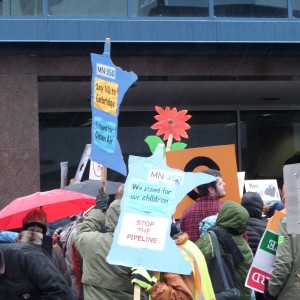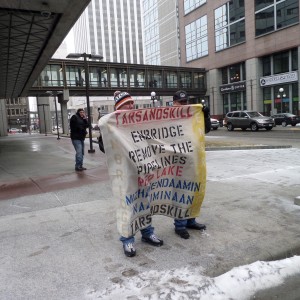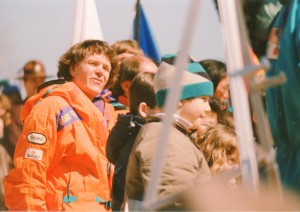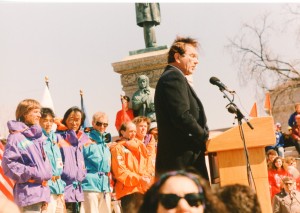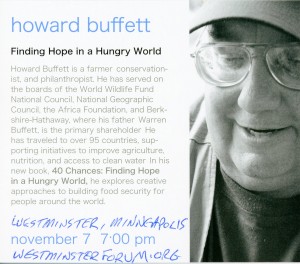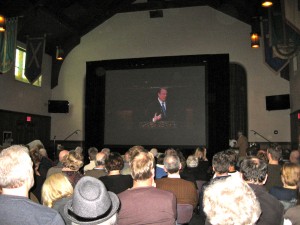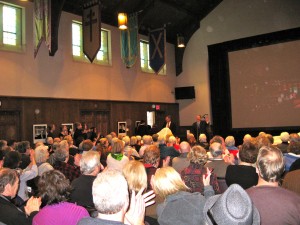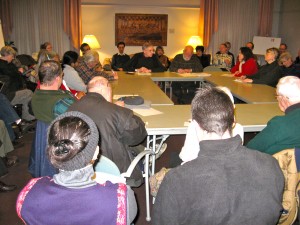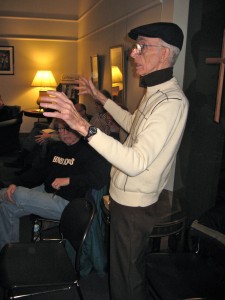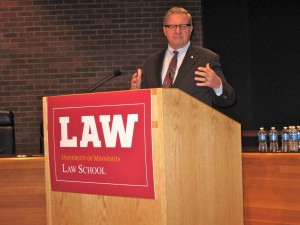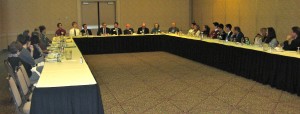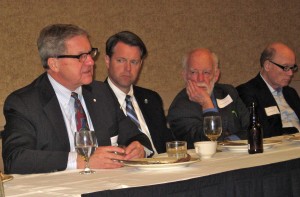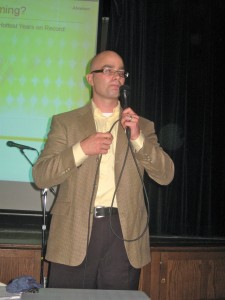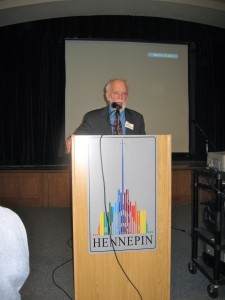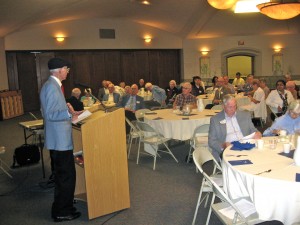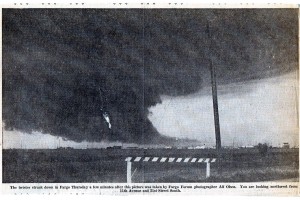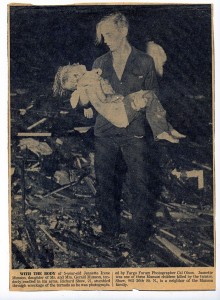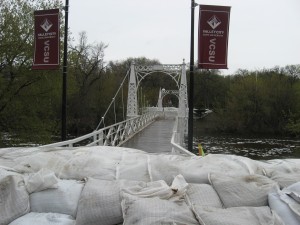UPDATE June 26, 2012: Here is the obituary on Lee Dechert.
NOTE: Comments on Lee from Andy Driscoll and Will Shapira can be found at the very end of this post. There may be others, later.
Richard Lee Dechert (that’s as in French: pronounced d-share) passed away quietly at home on June 21. Years ago I heard a man eulogized as follows: “he lived before he died; he died before he was finished”. This would fit Lee Dechert who passed away June 21, 2012, in St. Paul.
There will be a formal obituary in the metro newspapers shortly. I am thinking that Lee would want his own words, which follow, passed along as well.
Every one who knew Lee, knew that his death was imminent. The cancer finally had its way. He was quietly eloquent about the progress of the disease and other ailments. They were simply part of his life as he lived it.
Lee (the only name I had for him) died with uncommon grace. May 17 I gave him a ride to (as far as I know) his final outside event, the Third Thursday program of Citizens for Global Solutions. Also in the car that night was the speaker for the evening, Pat Hamilton of the Science Museum of Minnesota. There are a couple of photos from that final outing for Lee at the end of this post.
My knowledge of Lee came from attendance at meetings with him, and occasional visits when I gave him a ride home. There were bits and pieces shared: his Air Force service in the 1950s, including a visit to Haiti; going to the University; his great pride in his daughter, son-in-law and then grandson; his love for his sister; sometimes a little talk about the illness, but never much. I gathered he was divorced, but we didn’t talk much about that, and when that was a brief topic, there was no sense of bitterness. Things apparently just didn’t work out. It seemed there was a continuing relationship of some sort.
At home I would hear from Lee from time to time. When I knew that his death was soon approaching, I consciously began to keep his e-mails. There were perhaps 15 of them in all. From those 15 I’ve decided to include several which articulated Lee’s passions and history. I’ve left the contents exactly as received. They are Lee talking, not me. I noted my computer spell check found nothing. Lee was meticulous.
This is a very long post. The counter says 4068 words. At minimum, scroll through….
If you knew Lee, you’ll want to read on. (Click to enlarge the photos which, except for the final one, came from Lee Dechert.)

Lee, daughter Sabrina, son Luc, Son-in-Law Marco and Jim Pagliarini, President of TPT Channel 2 December 20, 2011
. Lee honored us by having us as audience stand-ins for him at Almanac May 11, 2012.
As Caitlin Mussmann says, you’re “go” for the show. Some background: Now approaching its 28th year, Almanac is the longest running (and most successful) local news and public affairs magazine in PBS history, and is a “must appear” venue for any aspiring candidate of a major federal, state or municipal office. Its co-creators, Bill Hanley and Brendan Henehan, are still senior staffers. Brendan is Almanac’s Executive Producer, and you’ll likely see him in the Control Room with longtime Associate Producer Kari Kennedy and longtime Director Jeff Weihe. Other members of the show’s crack production crew have been there 15 to 20 years or more. The late Judge Joe Summers was the first Co-Host along with Jan Smaby. In the 1960’s I knew Joe as a DFL activist, and I knew Jan as a teenager at my and my wife’s Lutheran parish near the U. of M. campus.
Under Bill’s leadership as Vice-President of Minnesota Productions, tpt launched the part-time local, digital Minnesota Channel (now MN Channel) 10 years ago. In 2006 it became the nationally acclaimed 24/7 statewide service it is now, with a groundbreaking business plan of co-producing or co-presenting a rich array of programs with local, state and regional non-profit organizations, and providing seed grants for low-income producers. Brendan is also the Executive Producer for the MN Channel’s public affairs programs. A major off-shoot of Almanac is Almanac: At the Capitol, created in 2006 with Kari as its Producer and Mary Lahammer as its Host. David Gillette became its Special Correspondent in 2010. Mary and David also report or commentate on Almanac. A major off-shoot of the MN Channel is the superb MN Original arts series that was launched in 2010 with funding from the State Legacy Amendment. Over the years Minnesota Productions has created a multitude of award-winning programs.
As you may recall Dick, then KTCA-TV operated from its Como Ave. studios near the State Fairgrounds. In 1988 it moved to the newly constructed Telecenter next to the St. Paul Union Depot on Fourth St., and became digital tpt in 2002. I started in the Member and Viewer Services unit in November 1991 and retired in May 2007; I had major throat surgery in June. Working with the public entailed working with staffers in every station unit, and I was blessed to be there when we began our fascinating transition from analog to multi-channel digital programming that culminated in 2006. With Governor Ventura presiding, in 1997 [1999? Ventura was elected in 1998] Minnesota’s first broadcast digital signal was switched on at the State Capitol; it subsequently led the state in a series of digital firsts. With the Governor was Jim Pagliarini who became the station’s President & CEO in 2007. Under his leadership tpt has remained one of the “gems” of the Public Broadcasting Service.
In 1982 my sister Bobbie, who died from cancer in October 2008, served as an MCAD arts intern at the station. In 1983 I, my wife Ann and daughter Sabrina were in the audience for the second-ever live filming of the half-hour Newton’s Apple show that aired on PBS until 1998. In 2006 Sabrina returned from Paris and opened her first stained-glass studio overlooking the Farmers Market from the Northwestern Building, a block on Fourth Street from the Depot and two blocks from tpt. Last December Sabrina, Marc-Antoine and little Luc took the James J. Hill Empire Builder from Seattle to St. Paul. And as the attached photos indicate, on December 20 Luc met some of my tpt associates who were thrilled to see him.
That is Luc, Marc-Antoine and I beneath the Almanac banner at the Lobby entrance; Luc, Sabrina and I before the Minnesota: A history of the land graphic in the Lobby; and the four of us with Jim Pagliarini at the station’s “Wall of Fame” across from Studio A. On the “Blenko Buddies” date Sabrina, Marc-Antoine (Marco) and I attended a special Studio A wine and cheese event for a Blenko Glass Company pledge show. On 8/2/07 Bobbie and I attended the station’s 50th Anniversary Alumni and Staff Party, and on 5/29/09 Bobbie’s partner John Sherrell met his friend Cathy Wurzer when he and I watched Almanac in Studio B and the Control Room much as you and your wife will. In her office my former manager Margaret took the photo of four-months old Luc checking his first gift from “Santa” (via me), a furry Minnesota Wood Duck. She also took our “Wall of Fame” photos.
If you wish, ask one of the Almanac crew for a marker to place your names and date on the massive “Wall” that graphically represents over 50 years of political and cultural history in Minnesota; First Lady Hillary Clinton is also on it. Before you leave also take a few minutes to review the station’s history at the hallway entrance to the studios. I’ll be there in spirit.

At TPT, December 20, 2011 photo received from Lee Dechert April 2012
: (August 26, 2009)
Along with Ann, I was a DFL State Convention delegate supporting A.M. “Sandy” Keith for Governor of Minnesota* when young and handsome Ted Kennedy, escorted by Irish bagpipers, delivered a stirring address on behalf of the party at the State Capitol Mall Armory in the summer of 1966. That was less than three years after his brother John’s death and he was treated with great reverence.
Ted and I were both born in 1932 a few months before FDR was elected in the depths of the Great Depression. My grandfather Everett, who married and lived with Nanny Kennedy in southern Ontario, and who died about a year after Uncle Lloyd was born in 1908 and mother was born in 1910, was a Scotch-Irish Kennedy whose clan history Bobbi traced when she journeyed through the British Isles in the 1990s. [Lee specifically noted that his Kennedy line was not part of that other Kennedy line!]
I still have the fine clan scarf she gave me, and wear it when I attend the St. Patrick’s Day Parade in St. Paul. It marches down 4th Street past the historic James J. Hill Northwestern Building where Sabrina had her stained-glass studio, and Twin Cities Public Television where Bobbi and I attended the 50th Anniversary Alumni and Staff Party on August 2, 2007. In 2008 Sabrina and I watched the Parade on a cold, windy March 17.
As I’ve mentioned before, when I hear those bagpipes and drums and see those magnificent uniforms, I always think of the Essex Scottish Regiment when it paraded through Great Grandmother Nanny Kiff’s Ontario village of Harrow to celebrate Dominion Day in the late 1930s and early 1940s. Grandfather Everett was a member of that Regiment and received one of the highest medals of the British Crown for his bravery in South Africa’s Boer War.
Long live the Kennedys! Long live “The Lion of the Senate”!
*”Sandy” lost the DFL nomination to incumbent DFL Governor Karl Rolvaag in a historic 21-ballot battle that lasted two days, lost the primary election, but went on to become a distinguished Chief Justice of the Minnesota Supreme Court. Our efforts were not wasted.
My Contribution to the Peace and Justice Community October 18, 2011. (Included here, Lee lays out the medical situation he was facing.)
[See] “Global Warming, Climate Chaos and Human Conflict” [
here]. The initial text concludes by saying:
“CO2 and other greenhouse gas emissions have raised the mean global temperature by 0.8 degrees Celsius since 1900, and 0.6 more has been locked in by climate system inertia. With the temperature continuing to rise about 0.2 degrees a decade since 1990—and with the U.S. and other Accord nations not doing enough to reverse the rise or adapt to it—the 1.5 and 2.0 limits will likely be exceeded well before 2050,[13-16,19] and the chaotic impacts of human-induced global warming will become the paramount issue of the 21st century.[6-9,20-23]
“Rampant conflict within and between nations is one of those impacts. Yet many U.S. ‘peace and justice’ organizations have not embraced a climate chaos agenda that could prevent or reduce the conflict. The APPENDIX of 26 conflict reports shows why such an agenda must be a key part of every organization’s actions. Moreover, because decades of human-induced global warming are locked into our planet’s climate system,[5] that agenda should primarily focus on implementing measures that will enable populations in our nation and other nations to adapt as best as they can to increasing climate chaos.[24]”
Dick, unless there were signs protesting the CO2 that was streaming from the tail pipes of the passing vehicles, “a climate chaos agenda” was not “a key part” of the Lake Street agenda. So I regard such
“peace and justice” protests as largely treating the symptoms of worldwide
“human conflict” rather than its underlying
“global warming” causes in which too many people are vying for too few resources in an increasingly hostile environment.
I just returned from a four-day visit with my sister, her partner and my nephew in the Rocky Mountains above Denver. I told them that the carcinomoid form of renal cell cancer that began in my surgically removed right kidney has metastasized to my lungs, is inoperable, can’t be treated with radiation therapy, and is usually fatal in less than a year with or without chemotherapy. Today I’ll have a third set of MRI and CT scans to determine how much the tiny “nodules” in my lungs have increased, and tomorrow I’ll meet with my oncologist to decide on initiating chemotherapy or palliative care. I’ll then inform my daughter and her husband in Seattle where I was the first family member to see and hold Luc two days after he was born.
If I’m able to attend Thursday’s Forum, I’ll distribute printouts of my piece. I hope to see you there.
Honduras Constitutional Crisis: A Proper Resolution (August 28, 2009)
I’ve reviewed over 500 reports and opinion pieces on the crisis from a wide range of sources and perspectives. In my judgment Honduras’ Supreme Court–supported by the Supreme Electoral Tribunal, Attorney General and democratically elected National Congress–had strong “probable cause” to arrest and detain President Manuel Zelaya for abuses of office and other crimes.
As prescribed by Honduras’ Constitution, President of Congress Roberto Micheletti (and leader of Zelaya’s Liberal Party) was selected to replace him (by a nearly unanimous 122 to 6 vote) as the interim President only until the November 2009 national elections are held and his term ends in January 2010.
However, Zelaya’s right to defend himself in a due-process proceeding was circumvented when military officers responsible for executing the Supreme Court’s order to arrest and detain him violated the order (and the statute that prohibits extradition of Honduran citizens) by forcibly expelling him to Costa Rica.
Since then the Supreme Court has ruled that Zelaya’s interim replacement by Micheletti was Constitutional and its order to arrest and detain him must be enforced.
Unfortunately if not tragically, the officers’ illegal expulsion has been erroneously conflated with the Court’s legal order, and both have been branded as a “military coup.”
Therefore, instead of circumventing that order by arbitrarily restoring him to the Presidency as the US-supported OAS Resolution demands and Oscar Arias’ San José Accord proposes, Zelaya should agree to return to Honduras and be duly adjudicated for his alleged treason, abuses of office and other crimes. Only then can his guilt or innocence be legally established and Honduras’ Constitutional crisis be properly resolved.
In addition the officers who expelled him should be duly adjudicated along with pro-Micheletti and pro-Zelaya forces who have violated the civil and human rights of Honduran citizens and foreign nationals. If Micheletti’s interim government does not curtail violations by army, police and other pro-Micheletti forces, even stronger economic and diplomatic sanctions should be applied by the US, OAS, UN and other international actors. Pro-Zelaya forces must also curtail their violations.
Moreover, Venezuela (supported by Cuba, Nicaragua and others) must end the blatant intervention in Honduras’ internal affairs that has exacerbated the crisis and violated the OAS and UN Charters.
In short, ALL parties to the crisis must resolve it by honoring the rule of law, not just the ones we may ideologically or politically favor.
Global Warming, Climate Chaos and the 2012 Minnesota Legislative Session (January 26, 2012)
As I’ve noted before, because of our climate system’s inertia in reacting to human-generated greenhouse gases, our state and the rest of our planet are locked into decades of chaotic global warming–even if all emissions were halted today. As I’ve also noted before, shaping government actions at state and local levels is crucial in adapting to warming impacts that include more frequent and extreme weather events in Minnesota and the Upper Midwest region.
As best as I can I’ll monitor the 2012 session, and if possible testify in behalf of legislation that will enable our state to better adapt to the chaos. I no longer use the term “climate change”; for urgent, effective adaptation it’s clearly outdated.
For those who wish to monitor the 2012 legislature, daily sessions are broadcast and streamed via the statewide Minnesota Channel (TPT-2 in the Twin Cities); e-mailed schedules are available from the House and Senate media services and from key committees; and daily reports are available from the the Minnesota Environmental Partnership (below) and Midwest Energy News; the latter also has regional and national reports; both can be Googled.
Regarding another warm environment, many thanks to the Board members who attended the delightful luncheon at the Olive Garden, and those who couldn’t attend but sent their best wishes.
RLD
======
Hopes for 2012 Legislative Session: Jobs and the environment, together
by Steve Morse, Minnesota Environmental Partnership [a former state legislator]
The 2012 Legislative Session kicks off this week!
While it’s anticipated that this session will focus on bonding, the Vikings stadium, and various constitutional amendments, important environmental issues will still be part of the policy discussion.
As legislators return to the state Capitol, we urge them to remember that policies that affect our water, clean energy future, and Great Outdoors are vitally important to Minnesota voters – regardless of political party affiliation.
In fact, a 2012 poll* of Minnesota voters found that the majority of voters do not believe that we have to choose between helping the economy vs. protecting our environment. A whopping 79% of voters polled said we can have a clean environment and a strong economy at the same time without having to choose one over the other.
Join us and tell your legislators and Governor Dayton that choosing the economy over the environment is a false choice – Minnesotans want and deserve both.
Having a strong economy and a healthy environment together will make Minnesota better today and for generations to come.
*From a statewide telephone poll of 500 registered Minnesota voters, conducted Jan. 9-11, 2012, for the Minnesota Environmental Partnership by the bipartisan research team of Fairbank, Maslin, Maullin, Metz & Associates and Public Opinion Strategies. The margin of sampling error for the full statewide samples is 4.4 percentage points, plus or minus; margins of error for subgroups within the sample will be larger.
Precinct Caucuses (February 1, 2012)
I’ll be the convener for my DFL precinct caucus in District 55A (partly Maplewood and North St. Paul). I’ll try to have my global-warming resolution passed and become a delegate to the District 55 Senate Convention where the resolution can be further discussed and hopefully passed on to the DFL State Convention.
I attended my first Maplewood precinct caucus with my wife Ann in 1966. We became delegates to the historic 20-ballot DFL State Convention at the Leamington Hotel in Minneapolis where A.M. “Sandy” Keith prevailed over Gov. Karl Rolvaag, but was defeated in a bitter primary election. Rolvaag was reelected and several years later “Sandy” was appointed to the State Supreme Court and became one of its finest Chief Justices.
I was also the titular campaign chairman, a lead organizer, and media publicist for a Catholic middle-school teacher in the Maplewood-North St. Paul School District by the name of Jerome “Jerry” Hughes. He upset a longtime GOP Sen. Les Westin, eventually became Chairman of the Senate Education Committee, received a Ph.D., authored groundbreaking early-education legislation, and spent the final years of a distinguished 28-year career as President of the Senate. I coined the campaign battle cry of “Less Westin and More Hughes!” It worked.
In 1968 my wife and I were delegates to the even more historic and divisive DFL State Convention at a St. Paul venue I don’t recall where Sen. Hubert Humphrey prevailed over Sen. Gene McCarthy. I was an anti-Vietnam War pro-Humphrey delegate and the District 50A Vice-Chairman. Our district was one of two in the entire Twin Cities region that sent Humphrey delegates to the ill-fated Democratic National Convention in Chicago. I received a personal letter of appreciation from Hubert, and he later autographed my book on “Midwestern Progressive Politics” at the Leamington.
That premier hotel where many historical events were held and guests like Richard Nixon, Dwight Eisenhower, Ronald Reagan, Lyndon Johnson, Hubert Humphrey and Duke Ellington stayed was demolished in 1990. Much of the site is a parking ramp for Orchestra Hall. I think of those 1960’s
events every time I attend a concert at
the Hall.
Here We Go Again…More Rollbacks for Environmental Protections (February 27, 2012)
As many of you may know, in the 2011 Minnesota legislative session the GOP-controlled House and Senate passed bills that repealed much of our state’s progressive environmental legislation—including laws that limit greenhouse gas emissions from coal-fired power plants and prohibit construction of new plants. Except for one relatively minor bill, Gov. Dayton vetoed them. This session they’re taking a different tack by passing bills that repeal state environmental rules and regulations—then require them to be submitted for approval by the legislature before state agencies can enforce them. Minnesota Environmental Partnership Executive Director (and former state senator) Steve Morse further explains that in his linked Loon Commons message and brief video. It is a major assault on public health and safety that’s occurring or has occurred in other states where the GOP controls the legislative process. It is similarly occurring in the U.S. House with the EPA and other federal agencies.
I hope our Chapter will join with other organizations in sending a letter opposing these bills to their authors and Gov. Dayton. I’m still available to assist in doing that.
Offer to include a link of Lee’s at AMillionCopies.Info (February 26, 2012)
Dick, thanks for your offer! As we know, without a livable environment there will be no lasting peace. The
United Nations Environment Programme (note the spelling) is perfect for your page. UNEP is celebrating its 40th birthday and on June 5, 2012 it will celebrate World Environment Day. Its Website is a treasure trove of information. I would place its link directly below the CGS link. RLD
Finally, I noted four of my blogposts where Lee ‘appeared’, usually with a comment at the end of the post. They can be accessed
here.

Luc, December 20, 2011, from Lee April 4, 2012

Lee, Sabrina and Luc at TPT, December 20, 2011, from Lee April 4, 2012

Photo taken Dec. 20, 2011, from Lee Dechert April 4, 2012
Well, now this calls for a short essay, which I’ll spare you right now. But, Lee Dechert was one of the smartest, most contradictory people I’ve ever known – not that being progressive and contradictory are necessarily mutually exclusive. He could be both, in series and in parallel.
This retiree from Channel 2, tpt, was ever critical of his colleagues for being in bed with corporations but who would defend to the death the institution’s value to the community and its viewers, even in retrospect. He was, for a progressive, immensely critical (if not totally accurate in his facts) of the RNC anarchists and journalists who goaded law enforcement into overreaction rather than place responsibility for restraint on the over-armed and over-armored former that confronted dissenters in the streets and were more violent than any of the protesters could possibly have been, putting property above person.
But Lee defended all of it, insisting that the aim of disrupting a constitutionally assembled convention was not theirs – the dissenters – to pursue. Certainly not with any sort of violence in their plan. And he let me know same in many an email and in no uncertain terms.
Lee was a great advocate of new technologies in the media while being an old-fashioned moralist himself and a critic of the direction mainstream media was taking – or ignoring – at our constitutional peril.
He could be one’s best friend one minute, grinning and praising and tearing you a new one the next, depending on the topic. But he never really held a grudge for the same reason.
I knew him not at all, despite these observations, but knew that he cared more for at least one of his sister’s health than his own during the days we worked together on the Media Reform Conference in Minneapolis.
And the hits just kept on coming. He was an excellent writer – off the cuff and after much work. Whether or not his reasoning coincided with the prevailing convention, it was ever his own, today a maverick, tomorrow a laissez-faire defender.
He will be missed – and remembered for all of that and more, and I heap my condolences on his family and friends.
Andy Driscoll
~~~~~~~~~~~~~~~~~~~~~~~~~~~~~
Andy Driscoll, Producer/Host,
TruthToTell – KFAI FM 90.3/106.7
Will Shapira, June 22, 2012
He was one of my best friends from Ch. 2-17 days and will be greatly missed by all.
He faced death more bravely than anyone I’ve ever known.
All Detroit sports teams should fly their flags at half mast.

My last photo of Lee, May 17, 2012, at Citizens for Global Solutions Third Thursday program featuring Dr. Pat Hamilton.

May 17, 2012


